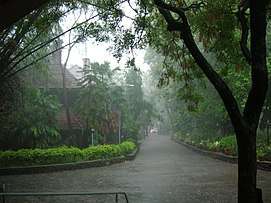National Film Archive of India
The National Film Archive of India (NFA) was established as a media unit of the Ministry of Information and Broadcasting in February 1964.[2] It is a member of the International Federation of Film Archives.
 | |
 Old NFAI building in the Monsoons (Pune) | |

| |
| Established | February 1964[1] |
|---|---|
| Location | Law College Rd, Deccan Gymkhana, Pune, Maharashtra 411004, India |
Objectives
Its three principal objectives are: to trace, acquire and preserve for posterity the heritage of Indian cinema; to classify, document data and undertake research relating to films; to act as a centre for the dissemination of film culture.[3]
Organization
With headquarters at Pune, Maharashtra, NFAI has three regional offices at Bangalore, Calcutta and Thiruvananthapuram. Developed from scratch by P. K. Nair,[4] NFAI's activities relating to dissemination of film culture are manifold. Its Distribution Library has about 25 active members throughout the country and it also organises joint screening programmes on weekly, fortnightly and monthly basis in six important centres. It has over 10,000 films, over 10,000 books, over 10,000 film scripts, and over 50,000 photographs. Another important programme is the film teaching scheme comprising long and short term Film Appreciation courses conducted in collaboration with the Film and Television Institute of India (FTII) and other educational and cultural institutions. At the International level, NFAI supplied several Indian classics for major screening programmes.
The NFAI's archive keeps a stock of films, video cassettes, DVDs, books, posters, stills, press clippings, slides, audio CDs, and disc records of Indian cinema dating back to the 1910s.
State of Preservation
On 8 January 2003, a large fire caused a massive destruction in the vault of NFAI housed in the Prabhat Studio complex of Film and Television Institute of India in Pune, in which unduplicated irreplaceable films with a nitrate base were destroyed.[5] Ravi Shankar Prasad the then Minister of State, Ministry of Information and Broadcasting, Government of India announced in the Rajya Sabha that 607 films in 5,097 reels were lost in the fire.[6] Among the greatest loss were films by Dadasaheb Phalke including: Raja Harishchandra, 1913; Lanka Dahan, 1917; Kaliya Mardan, 1919. Important films produced by Prabhat Film Company, Wadia Movietone, Bombay Talkies and New Theatres, were also gutted, namely: Bhakta Prahlada, 1932; Amar Jyoti, 1936; Manoos, 1939 Aage Badho, 1947.[7]
In March 2019, the Comptroller and Auditor General of India reported that 31,000 reels at the NFAI were reported lost or destroyed, when it audited the records between May 1, 2015 and September 30, 2017.[8]
References
- Publications Division (15 September 2017). Mass Media in India 1992. Publications Division Ministry of Information & Broadcasting. pp. 2–. ISBN 978-81-230-2566-7.
- T. M. Ramachandran; S. Rukmini (1985). 70 Years of Indian Cinema, 1913-1983. CINEMA India-International. pp. 530-. ISBN 978-0-86132-090-5.
- India. Ministry of Information and Broadcasting (1978). Report. The Ministry. pp. 40-.
- "Rescuing film prints from floods, fire and ignorance: tales from the pioneer of archiving in India". scroll.in. 1 April 2017.
- "Over 600 rare films reduced to ashes in fire mishap at National Film Archives of India". India Today. 27 January 2013.
- "14 years after fire destroyed hundreds of films, lessons not yet learnt". Indian Express. 19 September 2017.
- "Fire at FTII". Frontline. 18 January 2003.
- "Over 31,000 Film Reels At Film Archives Body Lost, Destroyed: Auditor CAG". NDTV. 17 March 2019.